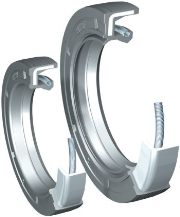 Phil Burge, communication manager at SKF, explores how the latest developments in seal technology are helping to improve the operating life and reliability, while reducing the lifetime costs of industrial and process pumps
Phil Burge, communication manager at SKF, explores how the latest developments in seal technology are helping to improve the operating life and reliability, while reducing the lifetime costs of industrial and process pumps
Industrial and process pumps present a tough operating environment for seals and gaskets, especially those designed to protect bearings and rotating shafts. Yet if a seal fails, contaminants will enter the unit, attack the bearing and the lubricant, which can dramatically cut the bearing service life. Consequently, this leads to pump failure and has a significant cost implication with regard to repair or replacement and the associated downtime.
Accordingly, the proper specification and selection of sealing systems for industrial and process pumps is vital to help sustain the service life of equipment and avoid the need for premature pump and bearing replacement or rebuilds. By collaborating with an experienced bearings and seals manufacturer such as SKF, companies can identify the most appropriate source for matching seals, including radial shaft and labyrinth seals, to various pump applications.
High performance technologies
Dynamic radial shaft seals have long been the most common types of sealing solutions for bearing arrangements in ANSI (American National Standards Institute) class medium duty applications. Functioning as barriers to retain lubricant and exclude contaminants, these seals feature a steel sheet or elastomer shell to which a lip seal is bonded to maintain the requisite interference fit of the seal in the housing bore. This elastomer or nitrile rubber composite sealing lip provides dynamic and static sealing against the shaft and should always point toward the material to be retained, effectively inwards towards the bearing and lubricant, particularly in pump power frames. For applications using synthetic fluids or chemically aggressive lubricants, some seal manufacturers have developed sealing lips made from special material variations so that there is a solution for almost any application.
Alternatively, for ANSI Enhanced and API (American Petroleum Institute) rated process pumps, labyrinth type seals, are increasingly being specified for heavier duty applications, as well as gaining acceptance in other service classes. These seals feature a dynamic, non-contacting internal path to exclude fluid and particle contamination, while retaining lubricating oil. Usually constructed from metal or plastic materials for chemical inertness, these seals, when installed correctly, have been proven to offer long and reliable service lives.
Once the most suitable sealing design has been identified, it is then crucial to evaluate all of the particular demands and relevant operating conditions to further guide in seal selection if you are to ensure a long service life with optimum performance. Indeed, key operating parameters, including surface speed, temperature, pressure and the surface finish preparation of shafts and seals, are particularly important factors to assess.
Surface speed
Each type of radial shaft seal has surface speed limits, but general seal performance will be reduced by higher shaft speeds, seal torque, power consumption, under-lip temperature and dynamic run-out. These all have the potential to shorten seal life.
The majority of standard small bore radial seals (under 200mm shaft diameter) are rated up to 18.3m/s or 3,600ft/min, while larger diameter seals can run to around 25.4m/s or 5,000ft/min, which is also within the capability of plastic labyrinth seals or bearing isolators. Metallic labyrinth seals, can be capable of running at speeds of up to 50.8m/s or 10,000ft/min. To exceed these speed recommendations calls for special design considerations.
There are, however, ways of overcoming the negative effects of higher shaft speeds by reducing the radial load of the lip seal or changing to a sealing material designed to withstand higher temperatures. An alternative lubricant type or viscosity, optimising the shaft sealing surface or opting for a non-contacting labyrinth seal design can also combat these problems.
Temperature
Each type of seal material has an optimum temperature range beyond which thermal stress will harden the elastomeric compound, causing it to crack. This is often the most common cause of failure in nitrile rubber. The thermal limit can, however, be extended to meet almost any pump system requirement by upgrading the seal material to a thermopolymer or PTFE.
Pressure
Pressure loading from system conditions or a fault, such as a plugged vent, will mechanically load and distort a seal’s lip profile. Standard radial seals are designed for only about 7psi, but special profile and materials are available to compensate for high pressures.
Surface finish
A smoother shaft surface will provide better sealing contact with a lip seal. For optimum radial lip seal performance and service life, a surface of between 0.20 and 0.43µm Ra (arithmetical mean roughness) is recommended with a machine lead of less than 0+/- 0.5 degrees. Contact surfaces for labyrinth seals are less critical.
Summary
With the seal manufacturers now offering a comprehensive range of solutions, users can select seal designs and materials to accomplish specific functions required in almost any application. By carefully evaluating all conditions and specifying the most appropriate solution, sealing systems will play a significant role in productivity and profitability.


